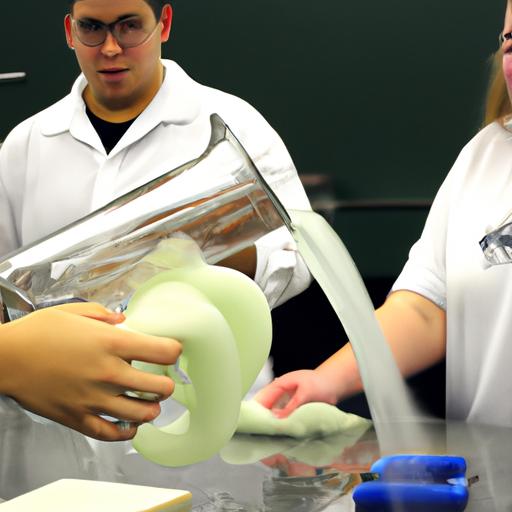Introduction
Have you ever wondered how a simple chemical reaction can create a mesmerizing explosion of foam? Enter the world of 3 h2o2 elephant toothpaste – an exciting experiment that captivates both young and old minds alike. In this article, we will dive into the science behind this intriguing reaction, provide a step-by-step guide to creating your own elephant toothpaste, and explore the educational applications of this experiment. So, let’s gear up and uncover the secrets of 3 H2O2 elephant toothpaste!

Chemical reaction between hydrogen peroxide and potassium iodide
The Science behind 3 H2O2 Elephant Toothpaste
At its core, 3 H2O2 elephant toothpaste is a demonstration of the rapid decomposition of hydrogen peroxide (H2O2) when mixed with a catalyst like potassium iodide (KI). When these two ingredients combine, a chemical reaction occurs, resulting in the release of oxygen gas and water. The dish soap added to the mixture acts as a surfactant, trapping the oxygen gas and creating the foamy eruption we associate with elephant toothpaste.
The decomposition of hydrogen peroxide can be represented by the following equation:
2 H2O2 → 2 H2O + O2The addition of potassium iodide as a catalyst speeds up the reaction, making it even more explosive. The catalyst provides an alternative pathway for the decomposition of hydrogen peroxide, allowing it to occur more quickly and efficiently.

Step-by-step guide to creating 3 H2O2 elephant toothpaste
Step-by-Step Guide to Creating 3 H2O2 Elephant Toothpaste
Now that we understand the science behind it, let’s embark on an adventure of creating our very own 3 H2O2 elephant toothpaste! Here’s a step-by-step guide to help you on your journey:
Materials Required:
- Hydrogen peroxide (12% concentration)
- Potassium iodide (KI)
- Dish soap
- Container (a plastic bottle or a beaker would work well)
Instructions:
- Ensure you have a well-ventilated area, preferably outdoors or in a well-ventilated room.
- Put on safety goggles and protective gloves to ensure your safety throughout the experiment.
- Take the container and place it on a stable surface.
- Pour 200 mL of hydrogen peroxide into the container.
- Add a few drops of dish soap to the hydrogen peroxide, stirring gently to mix them together.
- Dissolve 1 tablespoon of potassium iodide in a small amount of water.
- Carefully add the potassium iodide solution to the container with the hydrogen peroxide and dish soap mixture.
- Step back and watch in awe as the foamy eruption of elephant toothpaste unfolds before your eyes!
Remember, safety should always be a top priority when conducting experiments. Adult supervision is strongly advised, especially when dealing with chemicals.

Students conducting the 3 H2O2 elephant toothpaste experiment in a high school lab
Educational Applications and Benefits of 3 H2O2 Elephant Toothpaste
Beyond the sheer excitement of the experiment, 3 H2O2 elephant toothpaste holds significant educational value. Let’s explore the various benefits and applications it offers:
1. Demonstrating Chemical Reactions:
The experiment vividly showcases the decomposition of hydrogen peroxide and highlights the role of catalysts in speeding up reactions. It provides a hands-on experience for students to witness a chemical reaction in action, fostering a deeper understanding of the principles involved.
2. Exploring Measurement and Precision:
To create the perfect elephant toothpaste, precise measurements are crucial. Students learn the importance of accurate measurement and the impact it has on experimental outcomes. This experiment encourages attention to detail and the significance of precision in scientific investigations.
3. Stimulating Curiosity and Critical Thinking:
The foamy eruption of elephant toothpaste sparks curiosity and ignites a sense of wonder in students. It encourages them to ask questions, make predictions, and develop hypotheses. By engaging in hands-on experimentation, students are encouraged to think critically and analyze the results.
4. Applying the Experiment in High School Labs:
The 3 H2O2 elephant toothpaste experiment finds its place in high school chemistry labs. Teachers can use it as a captivating demonstration to introduce concepts like chemical reactions, catalysts, and the importance of following safety protocols. It adds an element of excitement to the classroom, fostering a love for science among students.
Conclusion
3 H2O2 elephant toothpaste is not merely a fun experiment; it is a gateway to understanding the wonders of science. By exploring the chemistry behind the foamy eruption, students develop a deeper appreciation for the role of chemical reactions and catalysts in our daily lives. The hands-on experience of creating elephant toothpaste engages young minds, fostering curiosity, critical thinking, and a passion for scientific exploration. So, gather your materials, put on your safety gear, and embark on a journey of scientific discovery with 3 H2O2 elephant toothpaste!
Toothpaste, Elephant Toothpaste Potassium Iodide Recipe, Elephant Toothpaste Ratio, Elephant Toothpaste High School Lab






